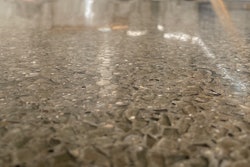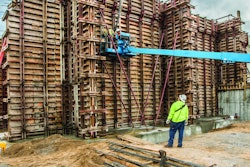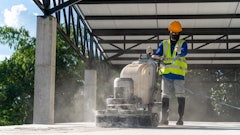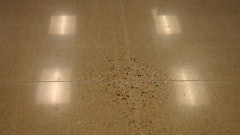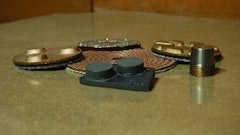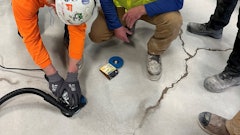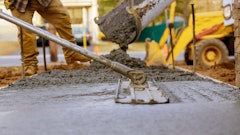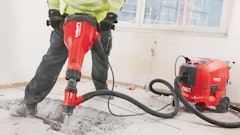
Polished concrete slabs continue to grow in popularity, necessitating that the contractor has the methods to produce them in the highest consistent quality. Early polished concrete floors began in the 1990s but by 2019, polished concrete floors accounted for approximately 53.5% of the U.S. market share of the concrete floor coatings market in terms of revenue, according to Grand View Research. Polished concrete slabs are found today in grocery stores, offices, retail, big box and residential. The increased use is fueled by the features polished concrete floors provide, such as high durability, long lifespan, easy maintenance, cost-effectiveness, high light reflectivity and aesthetic appeal. As expected, this sector is projected to increase in the coming years.
 The gloss (reflectance) measurements for polished concrete slabs show how much shine there is in the surface. Here the polished concrete slabs reflect the overhead lighting at a Sprouts Farmers Market.Courtesy of Patrick Harrison
The gloss (reflectance) measurements for polished concrete slabs show how much shine there is in the surface. Here the polished concrete slabs reflect the overhead lighting at a Sprouts Farmers Market.Courtesy of Patrick Harrison
What’s in the Spec?
Information in the new ACI 310.1 specification is easy to find because it follows the standard three-part format, General, Products and Execution. Requirements are detailed for testing and inspection, quality control, quality assurance, evaluation, and both acceptance and protection of polished concrete slab finishes. In the execution section, surface finish requirements, coloring, grinding and polishing, as well as repair are covered.
The new specification recognizes that there are many variables for each project that must be identified. The architect/engineer’s document needs to spell out project specific requirements, such as aggregate exposure and the expectations of the aesthetic. The included mandatory requirements checklist and optional requirements checklist guides the architect/engineer in customizing the specification to individual project requirements, whether it may be defining the specular gloss of polished slab finish, adding color or requiring additional testing.
Importance of Testing
The new specification recommends requiring measurements of the aesthetics and defines how the data should be collected. This includes Distinctiveness of Image (DOI), which encompasses clarity and how well a slab surface was properly refined during the sequence of polishing steps, so there is a means to measure its quality. Gloss (reflectance) measurements show how much shine there is in the surface. Measurements provide a more objective definition of the surface aesthetics. Haze is also defined in the document, which is often an indication of the inclusion of topical products to produce the aesthetic.
Currently, testing of polished concrete slabs is not consistent. Many contractors have not been collecting enough readings and are assuming that they’re achieving a certain measurable level of performance in the aesthetic. Contractors often are only testing a small mock-up area and then assuming they are reproducing the polished results with the same materials and techniques, without actually testing on the final slab. The newly released ACI 310.1 specification provides the framework for consistently testing throughout the day and how to report the results. The consistent testing on jobs also provides contractors with a measurable history of results to use in future bids.
 The new Specification for Polished Concrete Slab Finishes (ACI 310.1) provides minimum standards that can be applied to any polished concrete slab finishes. Cabela’s is one of the retail establishments known for using polished concrete slabs.Courtesy of Patrick Harrison
The new Specification for Polished Concrete Slab Finishes (ACI 310.1) provides minimum standards that can be applied to any polished concrete slab finishes. Cabela’s is one of the retail establishments known for using polished concrete slabs.Courtesy of Patrick Harrison
Outlined in the newly available document is when to perform the various types of testing. For example, at least two weeks before owner’s possession, testing must include specular gloss in accordance with ASTM D523, Distinctiveness of Image (DOI) in accordance with ASTM 5767, and haze in accordance with ASTM D4039. The new ACI 310.1 specification also indicates the testing locations for each type of test, but the designer of record will need to identify minimum requirements for DOI, gloss and haze. By providing guidance on which tests to perform and when, the document delivers a roadmap to ensure the slab is meeting the requirements outlined in the contract.
Both testing and reporting communication is important to ensure all parties – the owner, architect/engineer and contractor –are aware that the slab is meeting the quality agreed upon. It’s a win-win situation: the owner is ensured a high-quality product and the contractor has measurable numbers to prove success.
Now available on ACI’s website, ACI 310.1 was designed through the joint efforts of ACI and the American Society of Concrete Contractors (ASCC). To aid contractors in conforming to the minimum standards outlined, ASCC is currently working on a guide for contractors that reflects the standards in this specification. Following the format of the new ACI 310.1 specification, the guide will provide commentary and explanation in any areas that where a contractor may need additional guidance. The ASCC guide to ACI 310.1 is expected to be published in mid-2021.





